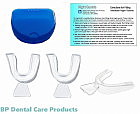 |
 |



Privacy Policy   |
| Frequently Asked
Questions about Teeth Whitening |
| The following FAQs should address most common customer
inquiries. But for any questions or concerns not found, please email us at support@bleachpro.com or click on the "Contact" button on the menu above. We will respond to your inquiry as soon as possible. |
| Q: Is teeth whitening really safe? A: Yes, years of dental whitening treatments by dental offices have shown that teeth bleaching is safe. When directions for use are followed, home use is also, safe and effective. If problems such as tooth sensitivity or gum irritations are experienced, the frequency of use should be reduced from every day to every few days or even once a week. Some people experience mild to moderate tooth sensitivity however, it is temporary and typically subsides within a day following treatment. Gum irritation is usually induced when too much whitening gel is applied to dental impression trays. When trays are formed well, only a very small amount of whitening gel is required to fill the space between gums and teeth. Any excess gel applied will remain suspended on gums causing potential irritation. |
| Q: What is Carbamide Peroxide? A: Carbamide Peroxide is the primary active ingredient or bleaching agent in the professional whitening gel. It is essentially a variation of Hydrogen Peroxide and it provides the oxidization chemical reaction required to safely penetrate porous tooth enamel in order to bleach and remove stubborn stains and embedded discolored matter. The Clinical Pharmacology Classification of Carbamide Peroxide states that there are "No significant interactions", although some temporary tooth sensitivity or gum irritation may be experienced. The perentage of Carbamide Peroxide listed for whitening gels or with reference to whitening kits, for example 22% or 35% Carbamide Peroxide, represents the amount of the active ingredient Carbamide Peroxide as a percentage of all gel ingredients. Dental offices generally dispense the same percentages of Carbamide Peroxide based whitening gels to their clients either in-office or as take-home kits. |
| Q: Is peroxide based teeth whitening OK for anyone? A: Although the majority of people who want whiter teeth will have no problem at all, there are certain conditions where teeth whitening is not recommended. Please reference the following: Cautionary Statement Bleach Pro Teeth Whitening Kits and Gel are intended for use by individuals with healthy teeth and gums. Use whitening gel according to the instructions. Gel should not be used by individuals with periodontal disease, braces, decayed teeth, open mouth sores or during pregnancy. You may experience some mild sensitivity to teeth and gums, which normally subsides a day after treatment. If sensitivity persists, reduce treatments to every few days or weekly and/or reduce the duration of each treatment. If increased discomfort occurs, discontinue use and consult your dentist. Keep out of children's reach. |
| Q: How does the whitening treatment work? A: A moldable dental "tray" or mouthpiece is submerged into mildly hot water for approximately 5 seconds or until it appears to be softened. Tray is immediately placed over teeth to obtain an impression for fit. After shaping the trays for upper and lower teeth, the whitening gel is applied to an individual tray and placed and over upper or lower teeth. One tray at a time is left in place for 20-30 minutes. Extending treatment times is at user discretion based on tolerance to gel. See basic illustration below.  Detailed instructions for molding dental trays and whitening gel use are supplied with each order. As the gel is activated, a slight tingling or bubbling sensation may be felt, which is the oxidation process taking place. Basically, the Carbamide Peroxide based ingredients penetrate porous tooth enamel, removing discolorations and stains. Whitening gel will remove stubborn stains from tobacco, coffee, tea, red wine, foods, and yellowing from aging. Treatment should be done on upper and lower teeth daily, weekly or at the user's discretion until desired whitening is achieved. |
| Q: What occurs during the bleaching process? A: During the bleaching process, the active ingredient in the gel, Carbamide Peroxide, is activated allowing oxygen to enter porous tooth enamel bleaching embedded discolored substances (stains). The structure of the tooth is not changed; only the tooth enamel becomes a lighter and whiter shade. Fillings, crowns, bridges and bondings, etc. are not affected. |
| Q: How long will the whitening results last? A: Tooth whitening is long lasting but not permanent. The whitening results remain until teeth have over time become reintroduced to stains from tobacco, red wines, certain foods, etc. Teeth Whitening products from Bleach Pro are not "supermarket" type whiteners and the gel is considerably stronger than most "As Seen On TV" type kits. The active ingredient in the whitening gel, Carbamide Peroxide is in professional dental office strength. However, reintroduced stains over time are common and may require an occasional touch-up to maintain a whitened appearance. |
| Q: What teeth conditions could benefit from peroxide based whitening? A: Most discolorations or staining of teeth can be whitened, but there are certain conditions that are more difficult to treat. Whitening can quickly treat the following conditions: * Stains from tobacco smoking or dipping smokeless tobacco. * Stains from exposure to certain foods, food colorings, coffee, wine, tea. * Yellowing of outer tooth enamel from natural aging. Discoloration of teeth from medications such as tetracycline and other medicines most commonly acquired during childhood tooth development, are more difficult to treat. Most common tooth stains and discolorations build up on the surface of enamel from the exterior of the tooth. However, certain medicines enter the tooth internally through the tooth root and blood supply. So, those discolorations are not easily removed through the external application of peroxide based gels. |
| Q: How many treatments will I get from a whitening gel syringe? A: The number of treatments in a syringe depends on how much whitening gel is applied by the user. When dental trays are properly formed, only a very small amount of whitening gel is required to provide tooth coverage. One of the most frequent mistakes made is applying a big strip of gel to fill the dental tray impression. When Carbamide Peroxide is activated, the whitening gel expands considerably. So, only a very small amount of gel dotted into the tray and spread out evenly using the syringe nozzle is enough to provide tooth coverage. It may look like it is not enough gel, but it is. Any excess amount applied to tray will result in gel remaining suspended on gums, which often causes irritation. With the proper amount of gel applied, the estimated number of treatments would be approximately 2 treatments per ml of gel. (A single treatment being 1 dental tray with gel applied). |
| Q: How long will it take before my teeth are whiter? A: Whitening results often become apparent during the first few treatments, but typically, a very noticeable whitening effect becomes evident after about 4-8 treatments. Teeth will continue to whiten with each successive treatment until desired results are achieved. Please note that it is not imperative to perform successive whitening treatments as fast as possible to achieve desired whitening. 10 treatments over 1 or 2 months will whiten teeth as much as doing 10 treatments in 10 days, for example. |
| Q: What strength whitening gel or kit should I purchase, 22%, 35% or maximum strength 44% gel? A: The whitening gel that Bleach Pro offers is developed by dental professionals and we sell much of our inventory to dental offices in the USA and internationally. Without question, most dentists would recommend the 22% carbamide peroxide whitening gel. The 22% formula is potent and whitens well and it is more pleasant to use than higher strength peroxide gels like 35% or maximum strength 44%. The 44% whitening gel can be harsh for some users and cautionary information should be read prior to use. There are many experienced whitening gel users and many have no issues and insist on the stronger gels, but not every user has the same tolerance to the common side effects noted. |
| Q: How important is the thermoforming process for dental impression trays? A: Dental tray forming is very important as well formed trays distribute whitening gel evenly over tooth surfaces. When trays are properly formed through easy hot water method, there should be very little space between tray walls and teeth, which also allows for less gel to be applied. |
ALL ORDERS PROCESSED VIA SECURE SERVER Bleach Pro Whitening, USA. All Rights Reserved. |